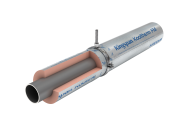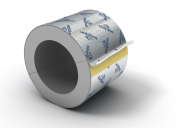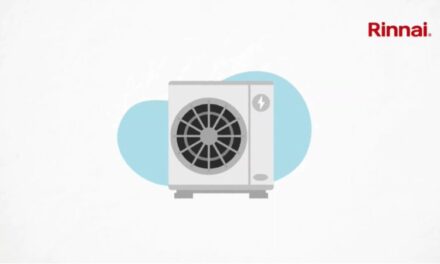 When it comes to energy management, seemingly minor changes can have a major impact on overall demand. A good example of this is the specification of insulated pipe supports. Most projects will include the installation of thousands of clamps / clips across various building services pipework. If they are not insulated effectively, they can allow significant heat loss from above ambient temperature services – potentially leading to a notable performance gap between the expected and actual building service performance. This is particularly true for smaller bore pipework where the frequency of supports is greatest.
When it comes to energy management, seemingly minor changes can have a major impact on overall demand. A good example of this is the specification of insulated pipe supports. Most projects will include the installation of thousands of clamps / clips across various building services pipework. If they are not insulated effectively, they can allow significant heat loss from above ambient temperature services – potentially leading to a notable performance gap between the expected and actual building service performance. This is particularly true for smaller bore pipework where the frequency of supports is greatest.
Poorly designed and insulated supports can also have a health impact on building occupants. Heat escaping from above ambient temperature pipework will warm the surrounding environment. Research from AECOM suggests that if continual running communal heating and hot water distribution systems are not effectively insulated, they can contribute towards overheating during the summer months. Conversely, poorly insulated supports around cold water pipework can lead to condensation and mould growth, impacting indoor air quality. They may also allow static cold water pipework to warm to a temperature range where Legionella bacteria is able to spread and grow rapidly.
For these reasons, it is important to carefully consider insulated pipe support options as part of a building services specification.
Pipe support options
When selecting insulation materials for any application the key performance metric is its thermal conductivity (also known as lambda value). This is the measure of how well a material prevents heat transfer through conduction. The lower the value, the more effective it is at resisting this form of heat transfer.
Historically, wooden blocks were used as inserts between the pipe and the metal support as their thermal conductivity is lower than that of the exposed metal. The thermal performance of these blocks is, however, still several orders of magnitude worse than modern insulation materials. This can allow considerable heat transfer and makes them vulnerable to rot if condensation occurs around below ambient temperature pipework. For this reason, BS 5970:2012 clearly states that wooden blocks “should not be used” in these applications.
Modern options include rubber lined clips, rock mineral fibre and phenolic insulation. There is still a good deal of divergence in the thermal conductivity of these materials and it is important to consider how this may impact the design and ease of installation, along with long-term maintenance. For example, with rock mineral fibre a significant thickness of insulation is still required to meet most system performance requirements. This can hamper installation and may even require service spacing to be widened.
Phenolic benefits
Phenolic insulation inserts provide the most thermally efficient option for pipe support applications, helping to prevent thermal bridging through the pipe support with a minimal thickness of insulation. This supports fast, simple installations whilst also reducing the space requirements for the services void.
Complete insulation systems are available which combine phenolic pipe insulation and insulated pipe supports. This ensures excellent continuity of insulation across the full length of the pipework and meets the recommendation within BS 5970:2012 that “load bearing pipe supports be of the same material, or compatible with, the thermal insulation on the pipework”.
The rigid structure of phenolic insulation also provides high levels of compressive strength – helping the inserts retain their shape and thermal performance over time. This is particularly important in horizontal applications where the pipe supports can be under considerable load. For additional protection on larger diameter pipework, some phenolic insulation systems are also available with metal spreader plates which wrap around the insert to effectively spread the load.
Thermal analysis
To better understand how different pipe support specifications can affect the heat loss from above ambient temperature systems, Kingspan Technical Insulation carried out a thermal analysis of a +75°C Low Temperature Hot Water (LTHW) system to BS EN ISO 10211: 2017. The analysis looked at four separate specifications:
-
Phenolic pipe support inserts
-
Rubber lined clip fixed to pipe
-
Metal clip fixed to the pipe
-
Wooden block pipe support insert
 The results confirmed that heat loss from the phenolic pipe support insert specification was four times lower than for the rubber clips, five times lower than the metal pipe clips and just one tenth of the losses from the wooden block infill.
The results confirmed that heat loss from the phenolic pipe support insert specification was four times lower than for the rubber clips, five times lower than the metal pipe clips and just one tenth of the losses from the wooden block infill.
The thermal analysis below clearly shows that both the metal and rubber lined clips allowed greater levels of heat transfer to the metal support rod. Whilst the wooden block pipe support limited heat transfer to the rod, more heat was able to escape across its large surface area due to its poor insulating properties. In contrast, the phenolic pipe support inserts provided an effective barrier to heat loss
Achieving optimal performance
Insulated pipe supports perform a small but important role in delivering buildings which use energy efficiently and provide healthy living environments for occupants. By specifying them as part of a complete phenolic pipe insulation system, it is possible to reach the desired level of thermal performance with a slimmer thickness of insulation – minimising long-term energy demand and allowing simpler installations and maintenance without increasing service space demands.
To find out more about how insulated pipe supports can benefit your project download the Kingspan Technical Insulation guide – Which Pipe Supports Are You Specifying?
For more information:
Tel: +44 (0) 1457 890400
Pipeline Technical Advisory Service: 0808 168 7363
E-mail: info@kingspaninsulation.co.uk




